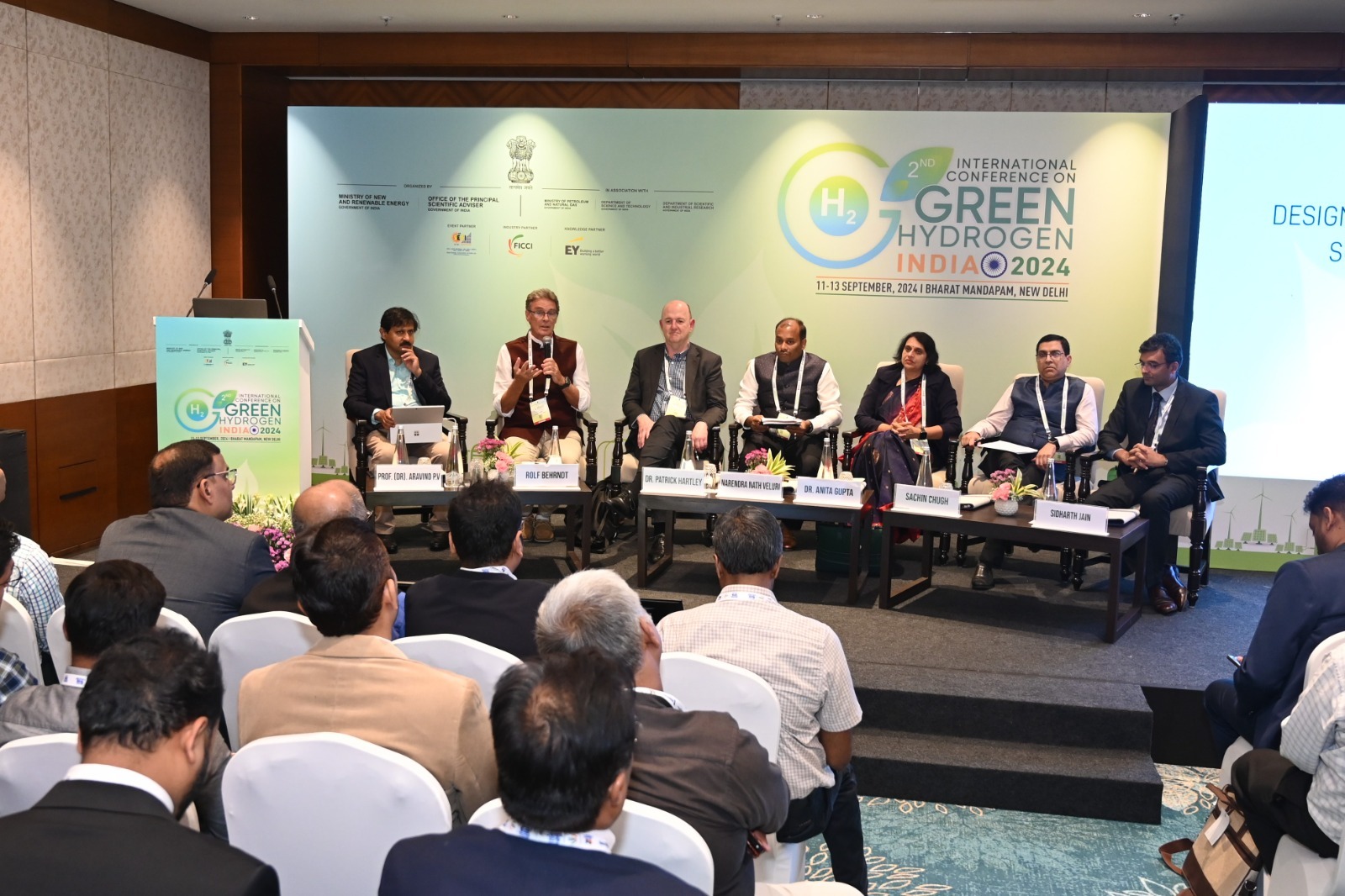
ആമുഖം ഗ്രീൻ ഹൈഡ്രജൻ (GH2) 2050 വരെ 1.5 ° C അല്ലെങ്കിൽ 2 ° C പാതയിൽ ആഗോള ഊർജ്ജ വ്യവസ്ഥയിൽ ഒരു ഊർജ്ജ വാഹകനായി നിർണായക പങ്ക് വഹിക്കുമെന്ന് പ്രതീക്ഷിക്കുന്നു. ജലത്തിൻ്റെ വൈദ്യുതവിശ്ലേഷണത്തിലൂടെ പുനരുപയോഗിക്കാവുന്ന ഊർജ്ജം ഉൽപ്പാദിപ്പിക്കുന്ന GH2 കാർബണൈസേഷൻ കൈവരിക്കുന്നതിന് നിർണായകമാകും. രാസവളങ്ങൾ, റിഫൈനറികൾ, മെഥനോൾ ഉൽപ്പാദനം, മാരിടൈം ഷിപ്പിംഗ്, ഇരുമ്പ്, ഉരുക്ക്, ഗതാഗത മേഖലകൾ, വൈദ്യുതീകരിക്കാൻ കഴിയാത്ത രാസ വ്യവസായം തുടങ്ങിയ ദുർഘടമായ മേഖലകൾ. ഇൻ്റർനാഷണൽ എനർജി ഏജൻസിയുടെ (IEA) കണക്കുകൾ പ്രകാരം, നെറ്റ് സീറോ എമിഷൻ 2021-2050 പാതയിൽ, 2050-ഓടെ ക്യുമുലേറ്റീവ് എമിഷൻ റിഡക്ഷനിൽ ഹൈഡ്രജൻ 6% സംഭാവന ചെയ്യുമെന്ന് കണക്കാക്കപ്പെടുന്നു, പ്രായോഗികമായി എല്ലാ ഹൈഡ്രജനും ലോ-കാർബൺ സാങ്കേതികവിദ്യകളെ അടിസ്ഥാനമാക്കിയാണ് (ഉദാ. കാർബൺ ക്യാപ്ചർ, യൂട്ടിലൈസേഷൻ, സ്റ്റോറേജ് (CCUS) എന്നിവയുള്ള വൈദ്യുതവിശ്ലേഷണം അല്ലെങ്കിൽ ഫോസിൽ ഇന്ധനങ്ങൾ. 2050-ഓടെ മൊത്തം അന്തിമ ഊർജ്ജ ഉപഭോഗത്തിൽ ഹൈഡ്രജൻ 10% സംഭാവന ചെയ്യുമെന്ന് പ്രതീക്ഷിക്കുന്നു, കൂടാതെ നെറ്റ് സീറോ എമിഷൻ 2050 പാതയിൽ ഹൈഡ്രജൻ ഉൽപാദനത്തിൻ്റെ (~60%) പ്രധാന ഉറവിടം വൈദ്യുതിയായിരിക്കും. ഗ്രീൻ ഹൈഡ്രജൻ പുനരുപയോഗ ഊർജത്തിൻ്റെ വ്യത്യസ്തവും ദുർബലവുമായ സ്വഭാവത്തെ പൂർത്തീകരിക്കുമെന്നും പ്രതീക്ഷിക്കുന്നു.
അനെർട്ടിൻ്റെ ഗ്രീൻ ഹൈഡ്രജൻ സംരംഭങ്ങൾ
2050-ഓടെ നെറ്റ് സീറോയും 2040-ഓടെ 100% റിന്യൂവബിൾ എനർജി സ്റ്റേറ്റും കൈവരിക്കാനാണ് കേരളം ലക്ഷ്യമിടുന്നത്. ഡീകാർബണൈസേഷനിലും നെറ്റ് സീറോ കൈവരിക്കുന്നതിലും GH2 നിർണായക പങ്ക് വഹിക്കുമെന്ന് പ്രതീക്ഷിക്കുന്നു. പുനരുപയോഗ ഊർജ സ്രോതസ്സുകളുടെ ലഭ്യത കാരണം പ്രാദേശിക ആവശ്യം നിറവേറ്റിയ ശേഷം GH2 ൻ്റെ സാധ്യതയുള്ള കയറ്റുമതി കേന്ദ്രമാകാൻ കേരളം ഒരുങ്ങുകയാണ്. കേരള സർക്കാർ പുനരുപയോഗ ഊർജ സ്ഥാപനമായ അനെർട്ടിനെ സംസ്ഥാനത്തെ ഹരിത ഹൈഡ്രജൻ പദ്ധതികളുടെ നോഡൽ ഏജൻസിയായി നാമനിർദ്ദേശം ചെയ്തിട്ടുണ്ട്.
കേരള സർക്കാർ പുനരുപയോഗ ഊർജ സ്ഥാപനമായ അനെർട്ടിനെ സംസ്ഥാനത്തെ ഹരിത ഹൈഡ്രജൻ പദ്ധതികളുടെ നോഡൽ ഏജൻസിയായി നാമനിർദ്ദേശം ചെയ്തിട്ടുണ്ട്.
മറ്റ് സംരംഭങ്ങൾ
കേരള സർക്കാർ ഗ്രീൻ ഹൈഡ്രജൻ സജീവമായി പ്രോത്സാഹിപ്പിക്കുന്നു. ഹരിത ഹൈഡ്രജൻ നയത്തിൻ്റെ കരട് സർക്കാരിൻ്റെ പരിഗണനയിലാണ്, ഉടൻ പ്രഖ്യാപിക്കുമെന്ന് പ്രതീക്ഷിക്കുന്നു. കേരളത്തിലെ 100% സൗരോർജ വിമാനത്താവളമായ കൊച്ചിൻ ഇൻ്റർനാഷണൽ എയർപോർട്ട് ലിമിറ്റഡ് (സിയാൽ) എയർപോർട്ട് വളപ്പിൽ ഗ്രീൻ ഹൈഡ്രജൻ പ്ലാൻ്റ് സ്ഥാപിക്കാൻ ബിപിസിഎല്ലുമായി (എംഒയു വഴി) കരാറിലേർപ്പെട്ടു. കരാർ പ്രകാരം, സംയോജിത ഗ്രീൻ ഹൈഡ്രജൻ പ്ലാൻ്റ് സ്ഥാപിക്കുന്നതിനും സാങ്കേതികവിദ്യ നൽകുന്ന ഇന്ധന സ്റ്റേഷൻ്റെയും പ്രവർത്തനങ്ങൾ നിയന്ത്രിക്കുന്നതിനും ബിപിസിഎൽ മേൽനോട്ടം വഹിക്കും. 500 kW ഇലക്ട്രോലൈസർ സിസ്റ്റത്തിൽ നിന്നുള്ള മൊത്തം GH2 ഉൽപ്പാദനം 100 Nm³/hour ആണ്. വിഴിഞ്ഞം തുറമുഖത്തിലേക്കുള്ള പ്രവേശനം കാരണം പച്ച ഹൈഡ്രജനെ കയറ്റുമതി അവസരമായാണ് കേരളം കാണുന്നത്. മൊത്തത്തിൽ, കേരളം അതിൻ്റെ ഹരിത ഹൈഡ്രജൻ വ്യവസായം വികസിപ്പിക്കുന്നതിൻ്റെ പ്രാരംഭ ഘട്ടത്തിലാണ്, എന്നാൽ സർക്കാർ, സ്വകാര്യ കമ്പനികളിൽ നിന്ന് കാര്യമായ താൽപ്പര്യവും പ്രവർത്തനവുമുണ്ട്. വിവിധ സ്വകാര്യ നിക്ഷേപകരിൽ നിന്ന് (എച്ച്എൽസി ഗ്രീൻ, ലീപ് ഗ്രീൻ, റിന്യൂ പവർ, എൻഫിനിറ്റി, ഓസിയോർ എനർജി മുതലായവ) കുറഞ്ഞത് 5 നിർദ്ദേശങ്ങളെങ്കിലും ലഭിച്ചിട്ടുണ്ട്, അവ സർക്കാരിൻ്റെ പരിഗണനയിലാണ്. ഗ്രീൻ ഹൈഡ്രജൻ ഗവേഷണവും വികസനവും പ്രോത്സാഹിപ്പിക്കുന്നതിൽ ANERT സജീവമായി ഏർപ്പെട്ടിരിക്കുന്നു. മൊത്തത്തിൽ, കേരളത്തിൻ്റെ ഗ്രീൻ ഹൈഡ്രജൻ പുഷ് ഒരു ബഹുമുഖ സമീപനമാണ്. വെല്ലുവിളികളെ അഭിസംബോധന ചെയ്യുന്നതിലൂടെയും സാധ്യമായ നേട്ടങ്ങൾ പ്രയോജനപ്പെടുത്തുന്നതിലൂടെയും സംസ്ഥാനത്തിന് ശുദ്ധമായ ഊർജ ഉൽപാദനത്തിൽ മുന്നിട്ടുനിൽക്കാനും ഹരിത ഭാവിയിലേക്ക് സംഭാവന നൽകാനും കഴിയും.
